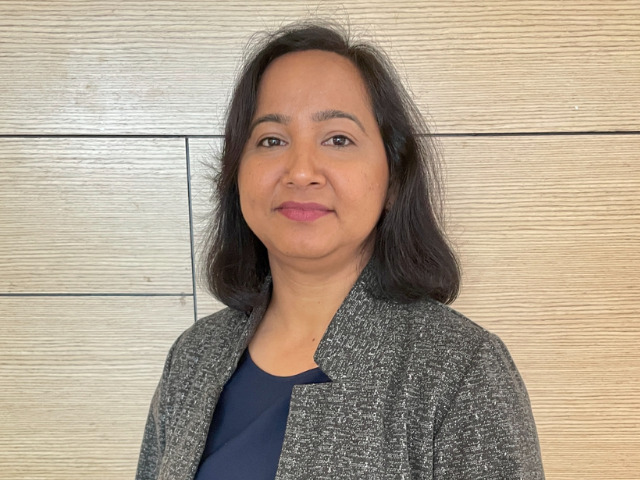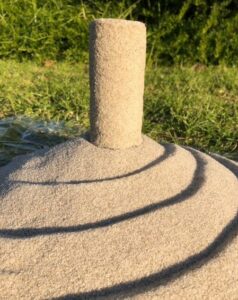
Significant increases in infrastructure development have led to the need to develop new and innovative soil improvement methods. In the past, many soil enhancement techniques have been developed which have a different degree of effectiveness in improving strength of soil over time.
With traditional methods requiring mixing cement with soil to bind soil particles together to enhance its strength; Tetra Tech Geotechnical Engineer Dr. Reena Hora is promoting research into alternative means to help reduce energy and environmental degradation in soil binding techniques. Here she shares her Leading with Science® insights into finding an alternative to this artificial material towards a sustainable future.
Reena has a Bachelor and Master’s in civil engineering, graduating in 2003. After juggling a consulting career, and raising a family, she took on a new challenge in 2015 commencing a fully funded PhD through the University of South Australia. Fuelled by her passion for research and continuous questioning of ‘can we do things differently’, Reena truly demonstrates that science and engineering go hand in hand together.
How is your research addressing sustainability in infrastructure development and the transition to alternative methods for soil binding?
My study involved exploring and applying an alternative method which is environment friendly and sustainable. This process is referred to as Microbial Induced Calcite Precipitation (MICP) which utilises the metabolic activity of naturally occurring bacteria to bind soil particles together, thereby enhancing the strength and stiffness of soil. The expected life of MICP treated soil is more than 50 years, which is compatible with the expected service life of many geotechnical structures. This technique utilises bacteria in a simple two step method where initially bacteria solution is injected into soil and allowed to rest for few hours. In the second step, nutritional feed is provided to bacteria many times which initiates a chemical process and bridges the gap between the soil particles.
MICP was successfully applied to three soil types with variable d10 (particle size) and were subjected to various laboratory testing such as triaxial, unconfined compressive strength and simple shear. The results demonstrate that bacteria can bind the soil particles with a substantial strength gain of as high as 6 times as compared to untreated soil.
What inspired you to commence study at this point of your professional career?
When I applied for my PhD scholarship I had more than nine years of professional experience, with different roles ranging from project management, client management, research as well as teaching in tertiary education.
But I was always passionate about going back to do research and have a strong desire to contribute to the technical field. I was initially hesitant to start study after a long gap from completing my Master’s but my life skills, maturity and family support helped in the journey along with considerable support from my supervisors and team members. So, my advice to any of my colleagues in our industry would be to not be afraid of adding knowledge, to retrain, do further study or even doing a PhD. I can say it happily that my knowledge and experiences added after doing a PhD are helping me to navigate effortlessly through my current role as a Geotechnical Engineer.
When you are not performing research, how are you helping Tetra Tech clients solve their problems?
As a geotechnical engineer, I am a part of the tailings team which provides design and management for tailings storage facilities. We provide support to our clients in various ways such as by conducting stability analysis, project management, construction support and conducting site investigations. Global Industry Standard on Tailings Management (GISTM) sets out framework for prioritizing safety throughout the life cycle of tailings facility. The GISTM underwent a Global tailings review process and as an outcome the new standard is committed towards preventing catastrophic failure as well as enhancing the safety of tailings facilities across globe. We are helping our clients to make their tailings facilities to be compliant with the new GISTM standards.
What inspired you to choose this avenue of research?
I have always been fascinated by natural formations and believe that we can learn so much by studying nature. My research study focussed on a sustainable and innovative method to find solution related to geotechnical field. This innovative method is similar to the process by which sea corals are made in ocean. This process is called biocementation. MICP is a form of biocementation where calcium carbonate is precipitated into the void spaces of the soil particles. It forms a bridge between the particles and that’s what gives its strength. So, I was looking into how much strength that gives to the soil?
To determine the strength, gain the untreated and treated samples were subjected to different testing methods. This was another aspect which got me interested in doing research in this filed as there is still a gap with the data on MICP treated sample tested under laboratory conditions. The strength gain for MICP samples was significant as compared to untreated samples and this was evident in all the different testing methods used during my research.
‘I explain it to people that when you take the sand from the beach in your hand, what happens, it just slips out from your hand. If I have to bind that sand, I will have to use some artificial material like cement in general. But the addition of artificial material degrades the environment so I want to explore how we can, using a very natural and environment friendly method, bind these soil particles.’

What does that mean for clients and infrastructure programs around the world?
My research study focussed on a sustainable and innovative method to find solution related to geotechnical field. Nowadays, general focus across government, community and our clients are to find sustainable solution to the existing problems. When everyone is thinking and acting alike for the betterment of the society and environment it eases the burden on everyone and helps us to undertake and fulfill the responsibilities efficiently.
As an engineer and researcher, I believe that sustainability is an important factor where we need to find a balance between finding the right solution for the technical problem and at the same time do minimal or no damage to the environment. We also have a big responsibility to preserve our limited resources, beautiful landscapes, and ecosystem for our future generations to enjoy.
What are some of the limitations to this type of technique?
To favour life, any microorganism requires a carbon source, energy source, water, and favourable conditions (pH, temperature etc.). Each of these components can inhibit microbial activity but most critical of them are environmental factors. Environmental factors mainly include pH, temperature and pore throat size (space). The bacteria used in MICP process can culture well between the temperature range of − C and require appropriate chemical concentration. MICP starts at a pH of 8.3 followed by an increasing rate until a pH of 9.0 is reached. The narrow pore spaces in between the small soil particles may form a hindrance to bacteria entry. Thus, the introduction of bacteria into soil requires a pore throat size greater than 0.4 μm as cell diameter usually ranges between 0.5 – 3 μm.
Other than the above limiting components the successful application of MICP also depends on the fixation and distribution of bacteria in appropriate pore spaces, injection method and sufficient nutrients provided to bacteria to complete the process.
What are the next steps with your research and where do you see the next evolution of study or application?
Understanding the process of biocementaion requires multidisciplinary knowledge from people of various disciplines. Although it has potential in a variety of fields, but numerous efforts need to be made to address vital questions essential for commercial scale applications. The complexity of the process is one of the barriers in taking this method successfully to large scale applications in addition to other factors such as slow speed, application procedure etc. The other area of research in the field of geotechnical could be to supplement the extensive experimental work conducted over few decades with the thorough analytical and numerical modelling.
Despite its limitations this method is gaining popularity and is being widely explored and applied in many areas such as mitigating soil erosion, dust control, removal of heavy metals, removal of calcium from wastewater, structural rehabilitation and many more. So, this method is not only for a specific field, but also a widespread technique with potential to be applied in many engineering applications.
Connect with Reena Hora on LinkedIn